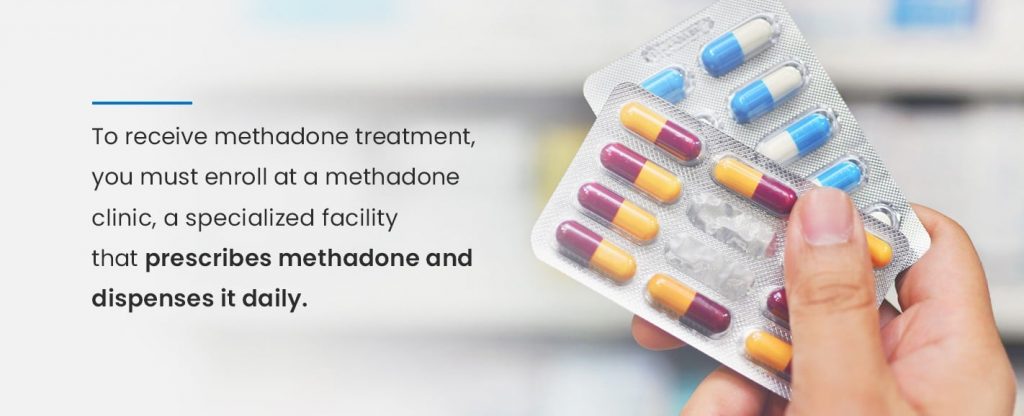When investigating possible options for treatment of opioid addiction, medication-assisted treatment (MAT) with either methadone or buprenorphine will invariably come up. MAT is defined as the use of certain medications approved by the Food and Drug Administration (FDA) in combination with behavioral therapies and counseling to treat opioid use disorders.
Research shows that MAT is far more effective as an intervention for opioid addiction than medication alone or behavioral interventions alone. While there are a few options for medications in an MAT program, methadone and buprenorphine are the most commonly used. To select the right treatment for yourself or help someone you care about find treatment, understanding more about methadone and buprenorphine is the first step.
What Is Methadone?
Methadone is the older of the two MAT medications. It was first produced in the 1930s and further developed during the 1960s. Its original purpose was to replace morphine as a painkiller with less addictive potential, but during the heroin resurgence of the 60s, it was found to have great potential as a means of facilitating addiction recovery by preventing withdrawal.
Methadone is an opioid agonist, meaning it attaches to and fully activates certain receptors in the brain. These are the same receptors targeted by heroin or prescription painkillers. However, the medication lasts longer in the body and at a therapeutic dose, does not cause euphoria or sedative effects.
By binding to opioid receptors, methadone satisfies the brain’s need and the person taking the medication will be able to avoid the painful withdrawal symptoms that may prevent recovery from ever beginning.
What Is Buprenorphine?
Buprenorphine is a much newer option for opioid addiction treatment. It was approved for treatment use in 2002, and while both medications are effective, there are differences. Buprenorphine is a partial opioid agonist, so it binds to opioid receptors but does not fully activate them. Like methadone, its binding action leads to reductions in cravings and alleviates withdrawal symptoms when taken by someone with an opioid use disorder. However, buprenorphine has a “ceiling effect” meaning that at a certain point, increasing the medication dose does not increase the effect. When taken as prescribed, this makes it less likely that an individual would overdose on buprenorphine compared to methadone.
Buprenorphine is sometimes formulated in combination with another medication called naloxone, and sold under a few brand names, the most well-known of which is Suboxone®. The addition of naloxone further prevents misuse of the drug. When Suboxone® is crushed and dissolved for injection, the naloxone causes withdrawal symptoms to set in immediately rather than producing the high the person is looking for — providing an effective deterrent for those who are susceptible to relapse. Additionally, the naloxone component prevents other illicit opioids from binding with the opioid receptors.
Frequently Asked Questions About Methadone and Buprenorphine
You know that the use of either methadone or buprenorphine can aid your recovery by preventing the worst symptoms of withdrawal and controlling your cravings, but you probably still have questions about one or both medications. Check out the answers to some of the most frequently asked questions about MAT using these two drugs.
Q: Isn’t MAT just substituting one addiction for another?
A: No. People take MAT medications to stop using drugs that cause serious interference in their lives and damage their physical and mental well-being. People participating in MAT can live their lives free from debilitating cravings and without experiencing the euphoria sought by those who are abusing drugs. Medication dosages are carefully controlled so that people being treated for addiction feel normal and more in control of themselves — the opposite of what happens when someone is actively addicted to a substance.
Q: Can I get addicted to methadone or buprenorphine?
A: Technically, yes. If methadone is carelessly prescribed or someone begins to take it in a manner not indicated by their provider, there is potential for addiction. One of the advantages of buprenorphine is that its action in the brain is more subtle and has significantly less addictive potential. Suboxone®, thanks to the inclusion of naloxone, is very difficult to abuse in the first place.
Q: How is methadone administered?
A: To receive methadone treatment, you must enroll at a methadone clinic, a specialized facility that prescribes methadone and dispenses it daily. You will have to attend the clinic every day for the first several months of your treatment until you meet the legal requirements to earn take-home privileges. Methadone is most commonly dispensed as an oral solutions when used for addiction treatment to reduce the possibility of diversion.

Q: How is buprenorphine administered?
A: Buprenorphine and Suboxone® treatment programs differ from methadone treatment in that you don’t need to attend a clinic daily. As you are stabilizing on the medication you may come more frequently, but when the maintenance phase is reached the visits will most often be every 28 days unless counseling or other resources are being utilized.
Buprenorphine comes in a few formulations. Some combination medications like Suboxone® come as a transmucosal film placed on the inside of the cheek, and others like Subutex® are sublingual tablets dissolved under the tongue.
Q: How long does MAT last?
A: The length of time spent participating in an MAT program depends entirely on your individual situation. While some people prefer to use MAT as a means of transition to sobriety with no medications, others find they benefit from the stability provided by the medication over the long-term. Because buprenorphine is relatively new, there is little research to suggest a minimum length of time for treatment. Methadone, however, should be taken for a minimum of 12 months for the best effect. MAT can be continued for any length of time deemed beneficial to the patient.
Q: Is MAT safe during pregnancy?
A: Yes. MAT is much safer for both mother and baby than continuing drug use and even medically-supervised detoxification. The American College of Obstetricians and Gynecologists (ACOG) recommends both methadone and buprenorphine as preferred treatments for expecting mothers. The medication that is right for each mother should be determined by collaboration between the treatment and obstetric providers.

Q: Do methadone and buprenorphine show up on drug screenings?
A: Neither medication will show up on a typical drug screen for opioids. As long as you have completely stopped abusing opioids and are only taking your prescribed medication, you do not have to worry about being denied a job or failing a probationary drug test due to MAT. Patients are covered by the Americans with Disabilities Act.
Getting Started With MAT at AppleGate Recovery
Opioid addiction is a complex disease that twists around every aspect of your life, affecting both mind and body. Medication-assisted treatment facilitates recovery by preventing the pain of withdrawal and stabilizing the individual so they can fully engage in the addiction counseling portion of the program.
If you or someone you care about are facing opioid addiction, getting appropriate treatment is essential to turning your life around. AppleGate Recovery is dedicated to providing evidence-based addiction treatment with buprenorphine and buprenorphine with naloxone to get you on the path to a happy, healthy life out of the shadow of opioid addiction. To speak to one of our compassionate counselors about healing from the effects of substance today, call (888) 488-5337 or get in touch through our contact form.

Contact AppleGate Recovery Today
If opioid addiction is impacting your life or the life of someone you care about, reach out to our treatment center. We are here to provide the support and care you need to take the first step toward recovery.
Call 888.488.5337
